The Baseball Break.
Two whole days on my trip without a football match so just what I am to do? Well, I am travelling by car, and obviously there is some scope for sightseeing as I drive north back from Los Angeles, with no plan until a 7 a.m. flight off San Jose. I started by driving up the Pacific Coast from Santa Monica to Ventura. It was not as interesting as I thought it may be. Picturesque in places, certainly but no more so than 100 stretches of European coastline. As was a grey overcast start to the day, and there were good waves for the surfers visible at every public beach, but it was also amazing how many people were picnicking in cars overlooking the beaches, or in some cases on the other side of the four lane highway! I left the coast and drove through a place call Ojai, where I stopped and brought a Turkey Club Sandwich I thought I would be able to eat it while driving along but it was over four inches thick. The drive over a mountain pass was quite spectacular, taking me quickly up from sea level to over 4000 feet, and then down almost all the way, and just as quick leaving me on a wide plain littered with the nodding donkeys used to pump up oil. Driving up the plain, I ended up at a sizable town called Fresno.
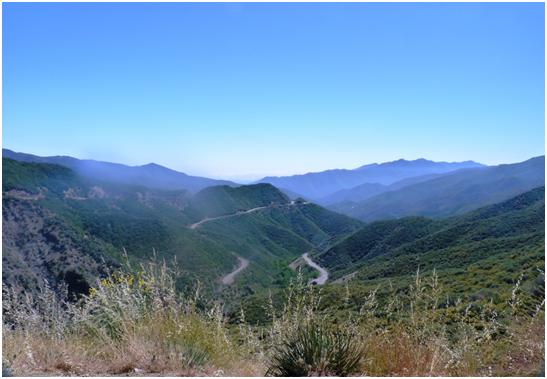
Near the centre of Fresno is Chukchansi Park, home of both the Fresno Feugos soccer team, (playing in the PDL), and Fresno Grizzlies Baseball Team. The stadium was originally called Grizzlies Park, but has taken on its current name, thanks to a sponsorship deal. The name comes from a local tribe of native American Indians, while the sponsorship comes from a casino on their lands.
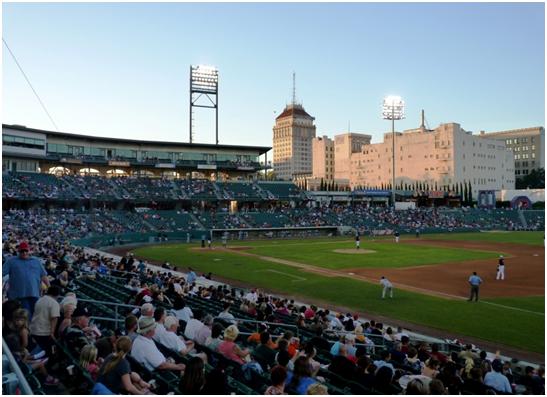
As you can see from the picture, this is a decent sized stadium, with a decent sized crowd, although I found the official figure, over 8000 difficult to believe. If the figure is correct, and a baseball match can attract a paying crowd of around 8000 a time and play the same opponents in a series that runs for three or four successive evenings, it is easy to see that this has the requirements for a successful professional sport. And Fresno is not part of the MLB Major League Baseball for which the scores are easily found in England. The Grizzlies are in fact a Triple-A rated Minor League team. This is the top level of the Minor League, but of course, there is no promotion for the best teams to the major league a franchise can only attempt to buy a franchise at the higher level. The players, of course are awaiting their chance at the top level. The Grizzlies are an affiliate of the San Francisco Giants, which means that most (might be all?) of their players are actually under contract to the Giants, as well as the coaching staff. The Giants have another five affiliated teams at lower levels of the minor leagues, with these players hoping to move up the rankings from the lower teams to the double or triple-A from where it is possible to jump up to the major league roster.
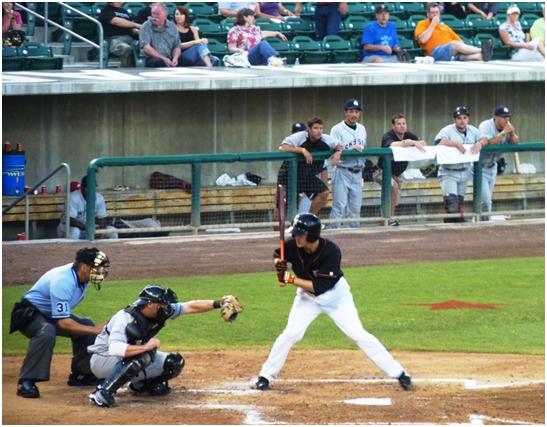
I arrived in Fresno barely before the scheduled start time, and found quite a queue outside the ground. As a result, by the time I had bought a ticket (US$10) and entered the ground, the first innings had been completed, and worse still the visitors, Colorado Springs Sky Sox were 4 runs to nil ahead. The next couple of innings were somewhat dull, but were over quickly. There was hardly a ‘hit’ in these innings. (This is when a batter hits the ball far enough to run to the first base before they fielders can get the ball there the ball must be in play (not behind the foul lines), and it is out if the ball is caught before bouncing. If the ball is hit directly into the crowd (not behind the foul lines), then this is a home run allowing the batter to complete a run around all the bases, and all those already on the bases to get home so a home run can score 1, 2, 3 or 4). The game turned on the fourth innings, when the home side suddenly started hitting the ball correctly, (perhaps the pitcher was tiring), and ran in six in the innings. Unlike Cricket, an innings does not involve every member of a team having a turn to bat, but a rotation of players ending when three men are out. The fifth and eighth innings involved both sides scoring one run, and the game finished after Colorado Springs failed to score in the ninth (and final) innings. The home side always bats last, and as there is no actual limit to the number of runs that can be scored in an innings, there is technically, always hope. The final innings does not happen if the home side is already ahead.

After the game, I looked around the town briefly there was no one about, even a few minutes after the game, and I felt better being in the car then I would have done walking. I could not spot any pubs or bars, and the only open store fronts appeared to be bail bondsmen of which there were a surprisingly high number. I counted at least six! I had a three hour drive to San Jose, stopping a couple of times on the way, once for a coffee, and once for an hour or two of sleep. I parked the car just after 4 in the morning, fine for a seven o’clock flight. A small, but full plane took me up to Portland, and after a short time testing the routes between airport and football stadium, I headed north to Seattle. Seattle is a more pleasant city, and is lively in the centre there were plenty of people walking about, and plenty of bars and restaurants. It did not suddenly get quiet after dark. It is typical of America, with a combination of older blocks (around 100 years old) in the centre, and the tall new skyscrapers. Some of the older buildings have a few flourishes, and I was quite taken by the Walruses on the frontage of one
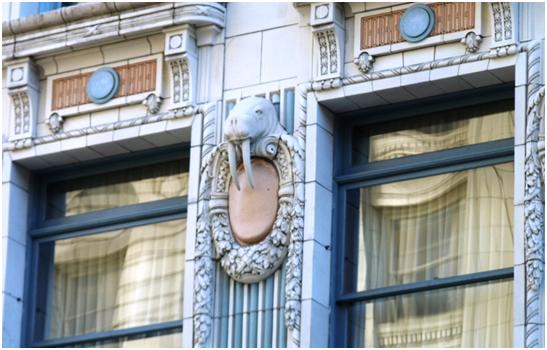
Naturally, I was in town to see the baseball and mindful of the delays the previous night, I headed to the ticket office early buying a top tier ticket for US$17. From the car park, I had to walk past Qwest Field normal home of Seattle Sounders, (and also the American Football team, Seahawks). To be honest the early ticket buying here was not required there was no shortage of available seats, and no crowd around the ticket booths just before the start. As a bonus, if I had waited, I could have dealt with a tout, and bought a ticket significantly below face value!
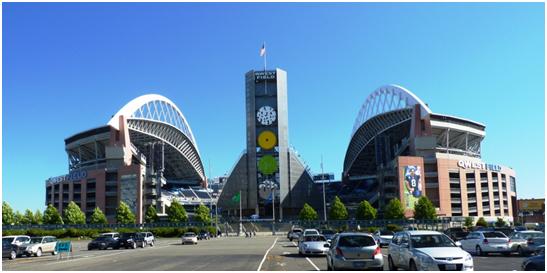
Close by the football and baseball fields, I found a couple of bars selling local ales. America is not a beer desert wherever one goes there is a selection of lagers, light ales, and almost always a stout and a Hefeweizen. Dark Ales are a little less common. When I asked at one of the bars in the centre about the next morning’s World Cup semi-final, he suggested not watching at the bar I was in, but heading instead to an area called Fremont. This is a recommendation that was well worth the effort, although the extremely busy “British Pub”, the George and Dragon was too busy meaning watching in the open air in a very hot courtyard, and I switched at half time to another bar, still busy but with room to sit down and watch from inside, (cooler, darker).
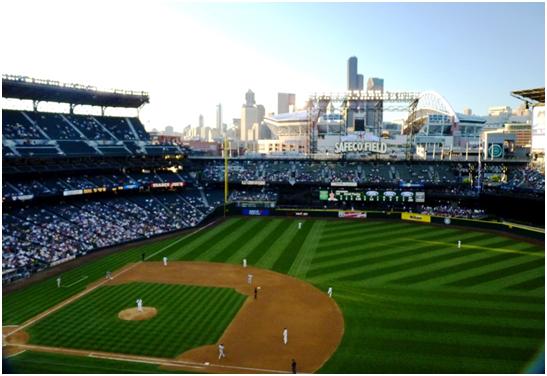
As for the baseball, the Seattle Mariners are in the middle of a bad run, and were playing four games against the Kansas City Royals, and were then going to follow with games against the New York Yankees. In may game, Seattle went ahead in the third innings with a home run, but then Kansas pulled themselves ahead by degrees scoring singles in the fifth, sixth and eighth. Seattle also scored in the eighth, pulling back to 3-2. This led to a tense final innings, as the home fans willed their team to score (in vain). It was however clear even to the untrained eye, that the better team on the day won. In fact, the better team continued to win, as Kansas had a clean sweep (winning all four), and New York have won twice since as I write. Still, the claimed attendance for my game was over 17,000 (the stadium holds at least twice this). Seattle did a monthly magazine, which features on all the teams visiting the Safeco Field (no prizes for realising this is a sponsor’s name) in the month, while Fresno did a smaller programme which dealt with a single series of games and one opponent only.
I noticed that from my seat (and for that matter any seat), it was almost impossible to say whether a pitch was good or bad. There were a few people nearby who had extraordinary powers of vision and claimed to know a ball was good (generally pitched by Seattle) or bad (pitched by Kansas), but these must come from the same group as those who can judge offside from behind the goal at the wrong end of the field. The only pitches I were certain of, could be said to be “very bad”. The decision therefore rests entirely with the umpire behind the plate. What was very noticeable is that there was hardly ever and dispute, and absolutely no analysis or criticism on television. The pitch may be replayed, but it is never analysed to see if the decision was right. Although the big debate about video referees was repeated on American TV with the overwhelming opinion being in favour, and the suggestion that not having video evidence could harm the progress of the game in America; Soccer was never compared to baseball in this regard. I was told that baseball officials did not want to break up play with the delays. But we had a delay at one point in each game, when the group of umpires decided they needed to discuss a point. There was time for a few beats of music (trying to get a response from the crowds, which in both games tended to watch quietly) before any pitch; and the game came to a stop every ten minutes or so at the end of the innings. At Fresno, these breaks were almost always filled with some other “action” on the field, whereas at Seattle, most of the “entertainment” was on the scoreboard. Most of the items at Fresno involved kids on the field of play, but one of the few I appreciated involved the pitch sweepers (who come on to smooth the dirt between innings) doing a dance routine. It is also obvious that the crowd is always in motion at both games. Very few people go to a ball game and see every pitch. The concourses behind is lined with stalls and concessions, selling food, club merchandise or just advertising goods. Once I took my seat at Fresno, I stayed in it until the end, whereas at Seattle, I went for a comfort break and a sausage about half way through the game, but starting at an innings break, I missed only about two or three pitches.
Incidentally, apart from the larger crowds the main difference between the Major and Minor League is accuracy. Far more pitches in the Major League game were good, and far more were hit. Of the balls that were hit, the ball went in the correct direction more often, whereas the Minor League players struggle to control the ball with a round bat. My guess is that if there is such a thing as amateur baseball, it would be almost unwatchable, unless the pace of the pitching was significantly reduced to increase accuracy.
I guess I could get used to baseball, although I imagine that spectators that watch every game of the home series are rare. After all, a baseball season involves around 80 home games. From what I could gather, a season ticket was not an admission ticket, but a discount card. The distances in America being what they are, away fans are a rarity in any sport, (although I saw Seattle fans in LA). Still, the next day would bring me back to soccer.